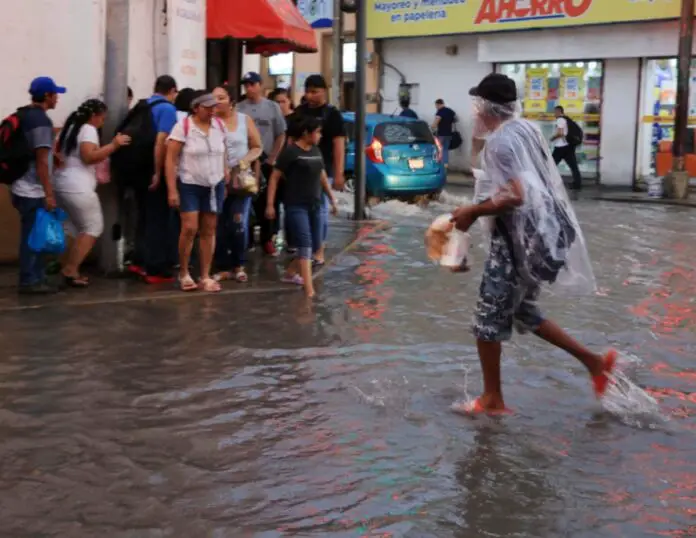Months with a summer flavor are expected for the autumn and winter season in Yucatán due to the influence of the “La Niña” phenomenon and climate change, indicated meteorologist Juan Vázquez Montalvo.
He also emphasized that there would be some coolness: the thermometer in Mérida would drop to an average of 15 degrees, and even in the interior of the state of Yucatán, temperatures would drop a bit more, but as soon as the sun rises, the heat will return.
The Yucatecan winter will be influenced by “La Niña,” which brings more humidity. With “El Niño,” it would have been cold.
There is not very good news for taking out sweaters and shawls, he commented.
The cold front season for the Mexican Republic begins on September 15 and ends on May 30.
How many cold fronts are expected in Mexico and how many will reach Yucatán?
The National Water Commission reported that 44 to 46 cold fronts are expected. The strongest will arrive at the end of December, January, and early February in the country.
For Yucatán, the situation is different, the specialist explained. The cold front season will start on October 15 and end on May 15.
The first cold fronts should arrive at the end of October or early November in Yucatán, and the last cold front is the famous “cordonazo” of the Holy Cross, on May 3.
Of the 44 to 46 cold fronts forecasted by the National Meteorological Service, half of them should reach Yucatán.
The strongest, like in other parts of Mexico, would arrive between December 20 and February 15, which is the peak of the cold front season, especially in January.
“La Niña” would bring Yucatán a winter with a summer flavor
The first cold fronts are generally rainy, as they will collide with hot and humid masses that will slow them down, turning them into troughs.
A trough is several low pressures, which causes it to start raining.
According to the meteorologist, the fronts that will bring coolness to the environment are those of November, but they can also arrive with rain.
Those in March and April would cause rains or gusts of wind like the “cordonazo” of the Holy Cross.
When will the “La Niña” phenomenon occur?
Vázquez Montalvo explained that we will have the “La Niña” phenomenon, which would start at any moment in October, and generally, there is not much cold.
The fronts are not very cold, at least for Yucatán. They arrive and cause coolness, but not low temperatures this season, much less record values.
With “El Niño,” the opposite happens: temperatures drop to 10 degrees.
When there is “La Niña” and a cold front arrives, very heavy rains have occurred during the Christmas holidays, as happened in 2020.
The meteorologist explained that there are always five or six cold fronts in December, six or seven in January, and six or seven in February.
The amount at the peak of the winter season is the same, only they do not arrive with much cold. He reiterated that January is the coldest month.
When “La Niña” is present, the minimum temperatures we have reached are 14 or 15 degrees in the Yucatecan capital.
The interior of the state has reached seven or eight degrees, but there have been no temperature records like in other years with the presence of “El Niño”.
Vázquez Montalvo indicated that this autumn and winter season will not be as cold because we will be under the conditions of “La Niña”.
There will be some coolness, the environment will be very humid, but not that biting cold, he commented. We are likely to have a winter with a summer flavor.
With “La Niña,” sometimes December 24th is very hot and the 31st is cold, or vice versa.
Hurricane “Kirk” in the Eastern Atlantic
The meteorologist said that Hurricane “Kirk” is in the Eastern Atlantic, without posing a danger to Yucatán.
According to him, the National Hurricane Center is monitoring a very large area from the south to the north of the Peninsula.
The area covers the Gulf of Mexico, where a low-pressure system is expected to form, and the center gives it a 40% (moderate probability) chance of developing into a cyclone in the next five to seven days. It would form in the south, center, or north of the Peninsula and should head to Florida.
Due to an area of rain, he explained, it would rain from today, Thursday, until next week.
When this disturbance reaches the Yucatán Channel, it could develop and merge with the bad weather in the Gulf of Mexico, where there is a low-pressure channel, which is why it is raining in some areas of the state and Mérida.
The forecast is that we will have a very rainy weekend, he added.
There would not be temperatures as low as 20, 30, and 40 years ago, says specialist Juan Vázquez Montalvo.
This is because the humid and warm air masses are increasingly moving north, preventing strong cold fronts from arriving, which weaken in the Gulf of Mexico or sometimes arrive so weak that they stall on the coast of Yucatán.
The specialist said that in about 40-50 years or even sooner, cold fronts will no longer reach the Yucatán Peninsula, and there will only be two seasons: one with rain and cyclones and one without rain or cyclones. This is where we are headed due to climate change, he warned.
It will take 40 years for the atmosphere to recover, and given the current situation, that will never happen; therefore, it is irreversible that we will have only heat, “we are going to roast.”
Source: Diario de Yucatan






